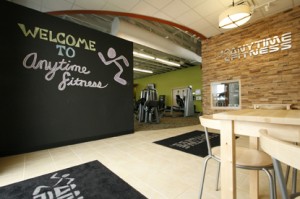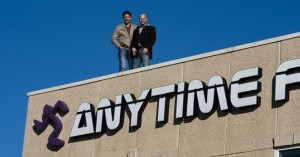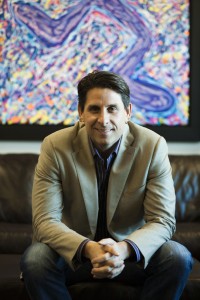Anytime Fitness co-founder and CEO Chuck Runyon decided in 2011 that he wanted to kick off 2012 with a bang. Not only did he want to increase the presence of Anytime Fitness, but he also wanted to attack the obesity epidemic at its source. So, with the assistance of Brian Zehetner, MS, RD, CSCS, the owner of Fueling Performance, and Rebecca Derossett, MSW, a social worker and behavior change expert in Stillwater, Minn., Runyon wrote his first book.
The book wasn’t meant to be a typical fitness inspiration book, but to actually tell people what they already believed about fitness, then use that knowledge to sway them into exercising. The title, “Working Out Sucks: And Why it Doesn’t Have To.”
“I’ve been saying for years now that working out sucks — trying to get our crew to understand that four out of five adults do not work out regularly, and that statistic needs to be reversed,” said Runyon. “Bottom line is, most people don’t enjoy working out. It’s effort, it’s sweat, it’s hard work — they don’t like to do it.”
The idea for the book came from Runyon’s belief that Anytime Fitness and the industry as a whole could use “a little more empathy.” He wants society to realize that club owners and people in the industry know that working out isn’t fun. “The alternative to not working out is much worse,” he said. “We are trying to use some logic, some emotion and some facts to get [non-exercising people] off their butt and get them to work out. I hope they get into a health club and I hope they choose Anytime Fitness, but if they don’t, I just hope they get up and start moving. This was not a sales pitch to join Anytime Fitness. Anytime was mentioned in the book, but it’s really a pitch to get people off the couch and get them moving.
“Our inspiration was to motivate the reader to start moving and make a positive difference in their life. Because their personal state of health has rippling effects into every area of their life — their families, friends, children, income, sex lives — even their pets. Hopefully, once they get moving they can encourage and inspire others. On a macro perspective, I’m concerned. You see these rising obesity rates in adults and in children and the projected obesity rates in 2020, 2030, 2040, what the heck is our country going to look and operate like if 50 or 60 percent of the people are obese? Escalating health care costs — those costs are going to continue to go up — and there are so many other consequences when people are out of shape. I think your fitness levels and how you feel about yourself influences every nook and cranny of your life. Every decision you make is, in some degree, sometimes boiled down to self-worth.”
It’s also Runyon’s belief that obesity and the many side effects directly impacts communities. “You health is not determined by the number on the scale. It’s also measured by your energy level, your stress level and nearly every decision you make,” he said. “As I pointed out in the book, there have been studies done on an active community versus a less active community and the unhealthy community has issues of higher crime, lower grades, higher teen pregnancy, more bullying — so, there are all these side effects to less active, unhealthy communities. As you look down the road 20, 30, 40 years, if we have a considerably higher amount of unhealthy communities, does that mean we are going to have lower grades, higher crime, higher teen pregnancy and more bullying, because the stats dictate that we will. It’s scary that if we don’t cure this disease of inactivity, what will our country be like?”
The major influence in “Working Out Sucks” doesn’t come from any of the three writers. Although highly impactful, they don’t have the same effectiveness as personalized fitness testimonials. Runyon utilized Anytime Fitness to find the best testimonials the company had to offer, then placed them strategically throughout the book to keep readers intrigued and prove that anyone could radically change their lifestyle, or just start exercising a little.
“I think one of the things [Anytime Fitness] does exceptionally well is we highlight our member success stories at our annual conference,” explained Runyon. “We keep in touch with our club owners throughout the year to identify these very inspirational stories of people of all ages, shapes and sizes. Whether it’s weight loss, someone fighting anorexia, whether it’s a couple on a journey together to lose weight — whatever it is, we are pretty good at identifying them and telling their story.”
These testimonials tug at the heart throughout “Working Out Sucks,” but they also play a major role in marketing for Anytime Fitness. On the company’s website, top testimonials are used to highlight the effects working out at an Anytime Fitness can have on an individual. They tell stories of people that are striving to walk again, and seniors that need their lives revitalized.
“If you attend to our annual conference, it’s the best part of the year for Anytime Fitness,” explained Runyon. “We have these member success stories come up on stage and Mark [Daly] does this five minute, emotional video on each. [In the video] he travels to their hometown and really captures their life, what this has meant to them and how being in better shape has made a radical difference in their life.”
Most people discover that being in better shape is more than just looking better, but it also provides a greater life experience. “What everyone will tell you is the difference it has made in the rest of their lives, not about vanity, but about relationships and just how they feel about themselves, and how much happier they are. I think our franchisees just fall in love with these member success stories. Those are real people from across the country.”
Many of the testimonials have spurred greater marketing and PR reach in the form of news articles in the U.S. The first example Runyon mentioned, which is also chronicled in the book, was the story of Daniel Lowe. Lowe was born with cerebral palsy, which caused problems in his walking ability throughout his entire adolescents. When Lowe turned 18 he set a goal to walk across the stage at his high school graduation to receive his diploma. “He’s from a single parent home,” explained Runyon. “Daniel and his mother live together and they didn’t have the money or resources to get a personal trainer and a membership. Our local club donated a membership, and in addition a local personal trainer donated his time, three hours a week, for weeks on end, to help Daniel gain the strength to walk across the stage for his high school diploma.”
The trainer didn’t know Anytime Fitness featured member success stories — he simply did the gesture to help Lowe reach his goal. Lowe had to have his hip broken and repaired by doctors, and then spend time with his personal trainer rehabbing the hip and getting strong enough to walk across the stage at graduation. “Without Anytime Fitness, Daniel doesn’t walk across that stage,” said Runyon. News outlets throughout Florida and the U.S. picked up Lowe’s journey, with videos and articles documenting his amazing story. Essentially, the story of Lowe cost Anytime Fitness some personal training hours, but because of kindness, it gained notoriety in its markets and assisted in membership growth.

Although Lowe’s story spurred regional, and some national news, it was slightly different than Runyon’s other example. Betty Lou Sweeney, who was awarded at an annual conference and also mentioned in the book, almost died in 2009 from a bladder infection. Sweeney began exercising at an Anytime Fitness location and transformed her life. “She lost over 120 lbs which is no small feat for a person in her 70’s and she discovered that she has this great talent in planking,” explained Runyon. “So, she goes on to set the world record in planking at just over 37 minutes. Here is a 71-year-old lady that just broke the world record.”
At the annual conference, tattoos of the Anytime Fitness running man have become popular. Hundreds of franchisees, employees and members in the Anytime Fitness system have the running man tattoo, including Runyon. When Anytime Fitness recognized Sweeney, she was tattooed, while planking, with half of the running man on her right calf. Her personal trainer, Dave Candra, received the other half of the running man on his left calf, and when the two line up their calves, they form one running man.
***
Although, writing a book will undoubtedly be a positive for Anytime Fitness, Runyon’s primary focus has remained at getting people healthy and fighting off obesity. In fact, in the opening pages of “Working Out Sucks” there is a short message from Runyon titled, “Book Profits Don’t Suck (But We’re Giving Them Away).”
Runyon wrote: “I hope this book inspires you in new and unexpected ways. And I’d like you to know that as part of our motivation in writing it, we’ve decided to give away 100 percent of the net proceeds to an organization that recently inspired me: Limbs for Life.
Limbs for Life is a global nonprofit organization that provides fully functional prosthetic care for individuals who can’t otherwise afford it. After twenty years of listening to flimsy excuses from able-bodied people, I have to admit, it’s refreshing to meet individuals who overcome a much more significant struggle every day — and who consider it a privilege (rather than an annoyance) to be physically active.”
“Working Out Sucks” gives people a piece of Runyon that they wouldn’t typically receive from the CEO and co-founder of a company. He’s compassionate about the obesity problem, but he’s also disturbed deeply by people that can exercise, but won’t. This deep-rooted annoyance of Runyon’s is discussed in the second chapter of his book, titled “Fifty-Fifty.”
In 1982, Runyon’s older brother Steve, who was born with a small hole in his heart, was to undergo a risky heart transplant. Throughout Steve’s life he was restricted to minimal physical activity. He would become winded easily and not be able to play competitively like the other kids, but Runyon said that never stopped him. “My brother was born with an excuse not to be active,” he said. “Most of us are born without excuses and it kind of drives me nuts that most of us are born with a silver spoon in our DNA. We’ve got nothing holding us back physically. Our arms work, our legs work, our hearts work; everything works fine, yet we still sit on the couch like lazy people. And our obesity rate is continuing to get worse.” Prior to the heart transplant, Steve’s parents were notified that he would have a 50-50 chance at survival. The doctors’ chances turned out negative and Steve lost his life during surgery. “This inspires me, because I feel I’m pretty lucky,” said Runyon. “I wasn’t born with anything holding me back. We have to live life at a higher capacity because we are able to.”
***
As Runyon kicks off his media tour to promote the book, he feels there are opportunities for clubs to begin targeting obesity in a different way. “As club owners, or trainers, or people who love fitness, we fall victim to the fact we think that everyone thinks like we do, that people like to work out or they’re addicted. We can’t understand why people can’t workout. I understand that most people just don’t like to workout, so I think we can be more empathetic as an industry to why people hate the aspect of working out and why they don’t want to spend the time or the money.”
But, just empathetically pushing people to exercise a little isn’t the end-all, be-all of fitness success and weight loss. Runyon said that nutrition is a major factor. However, the average consumer doesn’t understand the balance of food to exercise. “We know how much money is in our bank account, and we know how much gas is in our car, but we have no idea how many calories we are putting into our bodies,” said Runyon. “We are trying to change the habits of that. Fitness is really about basic math. If you consume more than you burn, you will gain weight. If you burn more than you consume you will lose weight.”
Runyon said the purpose of Anytime Fitness is to get people in and out as quickly as possible while getting a great workout. “Once you get in the club, we are going to interact with you and see how you’re doing, but we’re trying to make your workout hassle free. We don’t have a lot of nutritional counseling inside the club, most of it is handled offsite.” When members are at home, they can create their own meal plans, with the virtual assistance of Anytime Fitness through the online program Anytime Health. “Your trainers, or people online can help you create your workout or diet plan. Our most popular log-on times are during the days of the week when people are at work. People are thinking about their health and nutrition once they are outside the club. We don’t want your visit to Anytime Fitness to be two hours, it should be 30 or 45 minutes, an hour at the most.”
When Runyon wrote “Working Out Sucks” he did so to help alleviate some of the discrepancies that people believe about the fitness industry — that everyone is a fitness addict that loves exercise more than anything else. Throughout the book he challenges individuals to spend 1 percent of their week exercising. He breaks everything down into basic math so that people can understand the amount of time they really need to be moving to be healthy. He challenges our world to get up off the couch and start moving, but he also challenges the fitness industry to refocus itself and become more sympathetic to the rest of the population as they come in to begin using the club. -CS
Tyler Montgomery is the Editor of Club Solutions Magazine. Contact him at tyler@clubsolutionsmagazine.com
Stay ahead in the fitness industry with exclusive updates!
Rachel Zabonick-Chonko is the editor-in-chief of Club Solutions Magazine. She can be reached at rachel@peakemedia.com.












